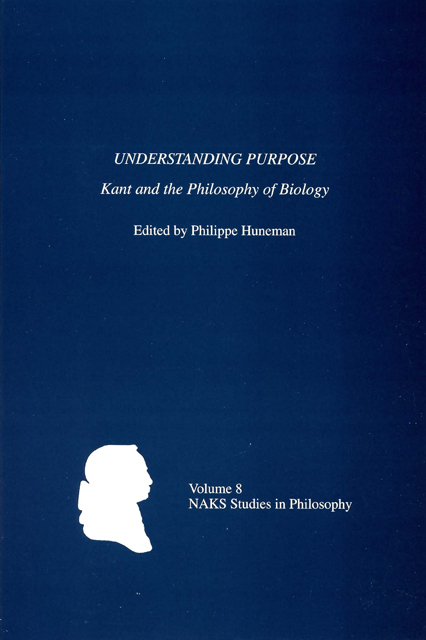Book contents
- Frontmatter
- Contents
- Acknowledgments
- Editor's Notes
- Introduction: Kant and Biology? A Quick Survey
- 1 Pre-Kantian Revival of Epigenesis: Caspar Friedrich Wolff's De formatione intestinorum (1768–69)
- 2 Kant's Persistent Ambivalence toward Epigenesis, 1764–90
- 3 Reflexive Judgment and Wolffian Embryology: Kant's Shift between the First and the Third Critiques
- 4 Kant's Explanatory Natural History: Generation and Classification of Organisms in Kant's Natural Philosophy
- 5 Succession of Functions and Classifications in Post-Kantian Naturphilosophie around 1800
- 6 Goethe's Use of Kant in the Erotics of Nature
- 7 Kant and British Bioscience
- Bibliography
- Contributors
- Index
4 - Kant's Explanatory Natural History: Generation and Classification of Organisms in Kant's Natural Philosophy
Published online by Cambridge University Press: 10 March 2023
- Frontmatter
- Contents
- Acknowledgments
- Editor's Notes
- Introduction: Kant and Biology? A Quick Survey
- 1 Pre-Kantian Revival of Epigenesis: Caspar Friedrich Wolff's De formatione intestinorum (1768–69)
- 2 Kant's Persistent Ambivalence toward Epigenesis, 1764–90
- 3 Reflexive Judgment and Wolffian Embryology: Kant's Shift between the First and the Third Critiques
- 4 Kant's Explanatory Natural History: Generation and Classification of Organisms in Kant's Natural Philosophy
- 5 Succession of Functions and Classifications in Post-Kantian Naturphilosophie around 1800
- 6 Goethe's Use of Kant in the Erotics of Nature
- 7 Kant and British Bioscience
- Bibliography
- Contributors
- Index
Summary
Abstract
There is a long tradition of Kant interpretation that takes seriously the importance of Kant's engagement with the sciences for understanding the aims and methods of his philosophical project. Given Kant's own explicit statements about the sciences, it is no surprise that much of the literature in this tradition focuses primarily on Kant's relationship to mathematics and physics. That is, the a priori element required by Kant for a discipline to deserve the honorifi c title of a science is most obviously met by mathematics (which is wholly a priori), and then, only slightly less obviously, by physics (which has both an a priori and an empirical element). What is somewhat surprising, however, is the relative lack of attention to Kant's engagement with another discipline that seems to concern him at least as much throughout his most productive philosophical years as does physics, namely, natural history. In this chapter, I not only suggest that natural history plays a more signifi - cant role within Kant's philosophy than is generally acknowledged, but I also argue that Kant's proposal for transforming natural history from a primarily descriptive discipline into an explanatory science represents a plausible answer to some of the most troubling questions, especially concerning generation and classifi cation, that face practicing naturalists at the end of the eighteenth century.
Introduction
In §81 of the “Critique of Teleological Judgment” Kant claims that although we cannot understand the generation of organized beings according solely to what he refers to as the “mechanism of nature,” we must not exempt these beings entirely from this mechanism if we are to continue viewing them as products of nature. In the process of explaining why this is the case, he provides what may appear to be simply a summary and evaluation of the various alternatives offered in the eighteenth century for explaining how organisms are generated. He takes the theories of preformation and epigenesis to be the only legitimate possibilities for providing this explanation, and then voices support for the theory of epigenesis on the basis of both experience and reason. In so doing, however, Kant makes a claim that should strike anyone familiar with the various debates concerning generation in the eighteenth century as odd, if not simply mistaken.
- Type
- Chapter
- Information
- Understanding PurposeKant and the Philosophy of Biology, pp. 101 - 122Publisher: Boydell & BrewerPrint publication year: 2007
- 5
- Cited by

